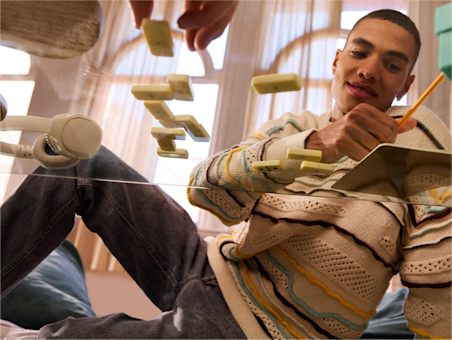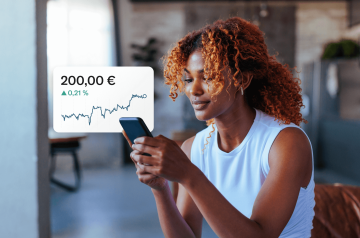Investing in ETFs: a practical guide
- Affordable: ETFs are passively managed and available as a monthly savings plan.
- Lower risk: They generally offer average returns and a high level of diversification.
- Easy to understand: ETFs are often a good pick for new investors.

What is an ETF?

How ETFs work
Benefits of Investing in ETFs

Diversification

Low fees

Liquidity

Transparency
Risks and other considerations with ETFs

Market risks

Tracking errors

Costs and fees

Synthetic index replication
Types of ETFs

Index ETFs
They track the performance of a specific index such as the S&P 500, MSCI World, or EURO STOXX 50.
Sector ETFs
These focus on companies from specific sectors, like technology, healthcare, or finance.

Commodity ETFs
With these ETFs, you can indirectly invest in various commodities, for example, in precious metals or the energy sector.
Income ETFs
They consist of stocks, bonds, and other asset classes, have low volatility, and can be a source of passive income.
How to start investing in ETFs

Define your financial goals
Be clear about why you want to invest your money in ETFs and what you’re trying to do — for example, save for retirement or repay a loan.

Set your budget
Get an overview of your monthly income and expenses, then determine how much money you have to spare for investing in ETFs.

Choose an investment strategy
Think about which types of ETFs interest you, how often or when you want to buy, and what level of risk you can take.

Set up a brokerage account
Choose a platform you trust where you can buy your preferred ETFs or set up ETF savings plans.
Choosing the right ETFs for you
The hands-off approach to investing: investment plans
- Automated: You can set an amount to invest automatically every month.
- Low cost: Unlike individual trades, there usually aren’t any fees.
- Small amounts: Depending on the provider, you can buy ETFs starting from just €1.
- Flexible: Adjust or pause your savings plan if money is tight.
- Long-term investment: ETF savings plans let you build wealth gradually.
- Easy to set up: Pick an ETF, set your savings amount, and relax — it's that simple!

Common ETF investing mistakes
Not investing at all
The longer you wait to invest your money, the more it loses value — no matter how much or little you’ve saved up.
Trying to time the market
Prices always stabilize around the average over time, but there’s no guaranteed way to predict price movements and game the system — as the saying goes, "time in the market beats timing the market.”
Emotional decisions
Watch out for stress, fear, or the “home bias” — market fluctuations are normal, and domestic investments aren’t always better than international ones.
Frequent trading
Buying and selling often comes with fees and other costs, so be careful not to overtrade.
Strategies for Investing in ETFs
Buy-and-hold
Buy-and-hold means that you purchase an investment — in this case, an ETF — and hold it long-term, no matter what the market does in the meantime. The goal is to benefit from market growth over a long period — often many years or even decades. Advantages: Low transaction costs, less time commitment, well-suited for long-term goals like retirement. Risks: Short-term market fluctuations can lead to losses, but the long-term focus helps to lower the risk.Core-satellite
This strategy combines a broad core investment (e.g., in a global equity ETF) with targeted investments in specialized ETFs (known in this context as satellites) or stocks focused on specific sectors, regions, or themes. Advantages: Diversification, option to still focus on certain market segments. Risks: The satellite investments may be more volatile and need to be monitored more closely.Dollar-cost averaging (DCA)
Dollar-cost averaging means regularly investing a fixed amount of money in a particular investment, no matter if the price is high or low. Instead of investing a large sum all at once, you break your investment into smaller, regular amounts over a longer period, often through a savings plan. Advantages: Reduces the risk of investing at the wrong time, spreads the base cost out over time. Risks: If the market starts rising quickly, overall costs could be higher than if you had just invested a lump sum at the beginning.Value investing
A value ETF buys stocks in companies that are considered undervalued. These companies usually have low prices/earnings ratios (P/E), high dividend yields, or other valuation metrics that show they're undervalued on the market compared to their real value. Advantages: Potential for above-average returns once the market re-evaluates the undervalued companies. Risks: Companies may be undervalued for good reasons, and there could be extended periods of poor performance.Growth investing
With a growth investing strategy, investors buy ETFs that concentrate on high-growth companies. These ETFs include stocks of companies that show fast growth in their revenue and earnings. The idea is that stock prices of these companies could potentially rise faster than the overall market over time. Advantages: Potential for high returns in emerging sectors and technologies. Risks: If growth slows down, those high valuations could turn into significant losses.Dividend investing
Dividend ETFs are exchange-traded funds that invest in companies known for paying regular and stable dividends. These ETFs aim for a combination of capital growth, dividend yield, and dividend growth. Advantages: Steady passive income, potential price growth. Risks: Dividend-paying companies are often more mature and may have less growth potential.Sector rotation
The idea of sector rotation for ETFs involves shifting investments by sector, depending on the current or upcoming phase of the economic cycle. For example, an investor might invest more in technology and industrial ETFs during an economic recovery period, but then shift to healthcare or consumer staples ETFs during a recession. Advantages: Uses normal market cycles to maximize returns. Risks: It’s all about good timing — you need to know what you’re doing and regularly monitor your investments.Global diversification
Global diversification means investing your money in various assets around the world rather than concentrating everything in a single region, industry, or asset class. This spreads out risk because different markets and regions respond differently to economic events. Advantages: Reduces risk by diversifying across different markets. Risks: Some regions might come with more currency risks and political uncertainties.Passive investing
Passive investing means investing in an ETF that tracks a specific market index. Instead of actively trying to select individual stocks or time the market, you put your money into a broadly diversified portfolio that mirrors an index (or several indices) and hold it over a long period. Advantages: Low costs, easy to manage, diversification. Risks: You are still exposed to market downturns.Tactical asset allocation (TAA)
Some investors will make temporary adjustments to their asset allocation based on short-term market opportunities or risks. Advantages: Chance to profit from short-term market changes. Risks: You need to actively manage your investments and might end up paying more in transaction costs.ETFs compared to other investment options
ETFs vs. individual stocks
Buying shares of a single company can be risky, because you only get a return on your investment if the company does well. With common shares, you receive voting rights and can participate in decisions at the general meeting. But this isn't the case with ETFs, as you don't hold direct shares in a company. For investors with short-term goals and relatively high wealth, buying stocks directly might be more attractive.ETFs vs. investment funds
Investment funds and ETFs both invest in many different stocks, bonds, commodities, or real estate. They also inherently have more diversification and liquidity than other types of investments. However, investment funds are significantly more expensive because they’re actively managed. Fund companies regularly change the composition of the funds to try to provide higher returns. This makes them riskier than ETFs, as the weighting of individual shares is ultimately in the hands of the fund manager — and if they make a mistake, it’s your money on the line.ETFs vs. lower-risk investment options
ETFs are considered safe, but they still carry risks. An even safer option is something like an interest-bearing savings account or a fixed-term deposit account, a savings bond, or a government bond. With fixed-term deposits, for example, you can invest your money for five or ten years at a guaranteed interest rate — even if the central bank raises or lowers the interest rate in the meantime. On the other hand, during the term, you won't have access to your money unless you close the account early and pay hefty penalties. Remember: You can diversify your portfolio with different ETFs. However, for truly broad risk distribution, it makes sense to also invest in other financial products, not just ETFs. For example, if you’re aiming for high returns, you could invest in stocks, crypto, and ETFs, while also setting some money aside for future purchases. Or, if you prefer to grow your savings in the long term, you could combine ETFs with some particularly low-risk options, such as bonds or a savings account.Invest in stocks, ETFs, and crypto

Find a plan for you
N26 Standard
The free* online bank account

€0.00/month
A virtual debit card
Free payments worldwide
Deposit protection
N26 Go
The debit card for everyday and travel





€9.90/month
Up to 5 free withdrawals in the Eurozone
Flight and luggage delay cover
Medical emergency cover
Winter activities insurance
Pandemic coverage
N26 Metal
The premium account with a metal card



€16.90/month
An 18-gram metal card
Up to 8 free withdrawals in the Eurozone
Purchase protection
Phone insurance
Dedicated N26 Metal line


